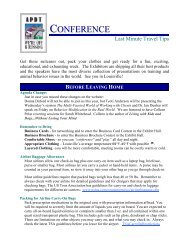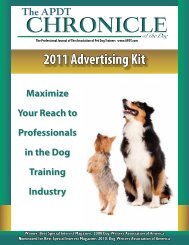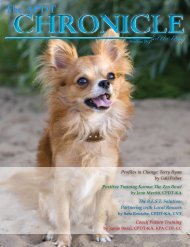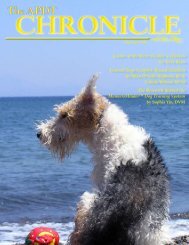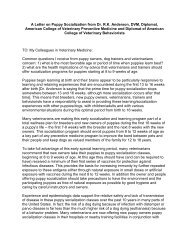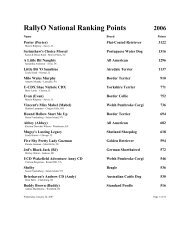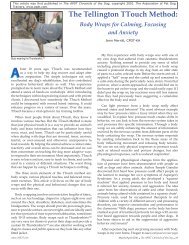of the Dog - Association of Pet Dog Trainers
of the Dog - Association of Pet Dog Trainers
of the Dog - Association of Pet Dog Trainers
Create successful ePaper yourself
Turn your PDF publications into a flip-book with our unique Google optimized e-Paper software.
(Riverside, CA) comparing 50 assessed and 50 unassessed<br />
dogs. Adopters reported incidents <strong>of</strong> growling in 14 <strong>of</strong> <strong>the</strong><br />
unassessed dogs and only three <strong>of</strong> <strong>the</strong> assessed dogs; five<br />
<strong>of</strong> <strong>the</strong> unassessed and one assessed dog bit but did not<br />
break <strong>the</strong> skin; and two unassessed dogs bit someone and<br />
broke <strong>the</strong> skin.<br />
Many facilities can benefit from an assessment tool that<br />
can help identify safety at intake. The use <strong>of</strong> MYM SAFER<br />
at intake was originally researched at <strong>the</strong> Wisconsin<br />
Humane Society in 2006. 41 owner-relinquished dogs<br />
were assessed at intake. Twenty one <strong>of</strong> <strong>the</strong> dogs scored<br />
“1’s” and “2’s” on <strong>the</strong> assessment at intake. Of those, 18 <strong>of</strong><br />
those scored “1’s” and “2’s” when assessed after staying<br />
in <strong>the</strong> facility approximately 24- 72 hours. In o<strong>the</strong>r words,<br />
86% <strong>of</strong> <strong>the</strong> dogs that scored “1’s” and “2’s” at intake scored<br />
<strong>the</strong> same after being housed in <strong>the</strong> facility for 1 3 days.<br />
Twenty dogs scored at least one “3,” “4” or “5.“ These<br />
dogs were also <strong>the</strong>n housed in <strong>the</strong> shelter for 1 3 days and<br />
<strong>the</strong>n reassessed. Two-thirds <strong>of</strong> <strong>the</strong>se dogs scored <strong>the</strong> same<br />
after being housed in <strong>the</strong> shelter, while one-third had ei<strong>the</strong>r<br />
a decreased level <strong>of</strong> potential aggression, or a behavior<br />
(such as food aggression) that was easily modifiable. Future<br />
research will focus on <strong>the</strong>se modest changes in behavior.<br />
How Does <strong>the</strong> Scoring Work?<br />
When a dog scores “1’s” and “2’s” on his assessment, he<br />
is less likely to bite under ordinary living situations when<br />
handled in a mildly stressful or moderately awkward<br />
manner than dogs who score “3s’,” “4’s” and “5’s.” <strong>Dog</strong>s that<br />
score “3’s” may be safe and inhibit <strong>the</strong>ir bite, but <strong>the</strong>y could<br />
be made safer by putting <strong>the</strong>m on a behavior modification<br />
program. <strong>Dog</strong>s that score “4’s” may have serious issues and<br />
should ei<strong>the</strong>r receive behavior modification training and<br />
<strong>the</strong>n be reassessed or only be adopted out to experienced<br />
adopters ready to manage <strong>the</strong> dog’s issues. <strong>Dog</strong>s whose<br />
behavior during one <strong>of</strong> <strong>the</strong> first four assessment items<br />
score a “5” have <strong>the</strong> highest probability to be a serious<br />
danger to staff, volunteers and visitors to <strong>the</strong> facility. They<br />
should only be handled by <strong>the</strong> shelter’s most experienced<br />
staff until <strong>the</strong>ir disposition is determined. These dogs may<br />
respond well to behavior modification or <strong>the</strong>y may not.<br />
It’s important to note that <strong>the</strong> assessment should be<br />
only one <strong>of</strong> many tools to help identify a dog’s potential<br />
for aggression. Owner relinquish information is vital to<br />
collect whenever available. Also be sure to collect behavior<br />
observations from <strong>the</strong> finder, animal control <strong>of</strong>ficer,<br />
veterinarian, kennel staff etc. [see table on page 12]<br />
www.APDT.com<br />
Behavior observed in home<br />
Number <strong>of</strong> reports in<br />
Assessed group (Group 1)<br />
How We Support Consistency in Assessments<br />
The certification program is an important part <strong>of</strong><br />
SAFER. Certification was developed in 2005. The MYM<br />
SAFER assessment is a tool that requires strong handling<br />
skills, body awareness, and a keen understanding <strong>of</strong> and<br />
<strong>the</strong> ability to objectively observe canine behavior. When<br />
<strong>the</strong> assessment was first introduced on a national level,<br />
<strong>the</strong>re was no certification process. Over time it became<br />
apparent that a certification process was necessary to<br />
insure that Assessors have <strong>the</strong> skills to conduct <strong>the</strong><br />
assessment correctly. Certification is achieved when an<br />
ASPCA MYM SAFER reviewer validates an Assessor’s<br />
skill in properly handling dogs and accurately scoring<br />
<strong>the</strong> appropriate behavior exhibited by <strong>the</strong> dog. This is<br />
accomplished through careful observation <strong>of</strong> assessments<br />
submitted on video and review <strong>of</strong> <strong>the</strong> corresponding<br />
SAFER worksheets. The certification is valid for one year<br />
after which recertification is required. To learn more about<br />
<strong>the</strong> certification go to www.aspcapro.org and click on <strong>the</strong><br />
Meet Your Match® link.<br />
MYM SAFER certification does [continued on next page]<br />
Number <strong>of</strong> reports in<br />
Unassessed group (Group 2)<br />
Nipping 4 14<br />
Food aggression 1 5<br />
Aggression around toys 2 5<br />
Growling at a human 1 10<br />
November/December 2008 w The APDT Chronicle <strong>of</strong> <strong>the</strong> <strong>Dog</strong> w 11<br />
Introduction to <strong>the</strong> ASPCA MYM SAFER Assessment



